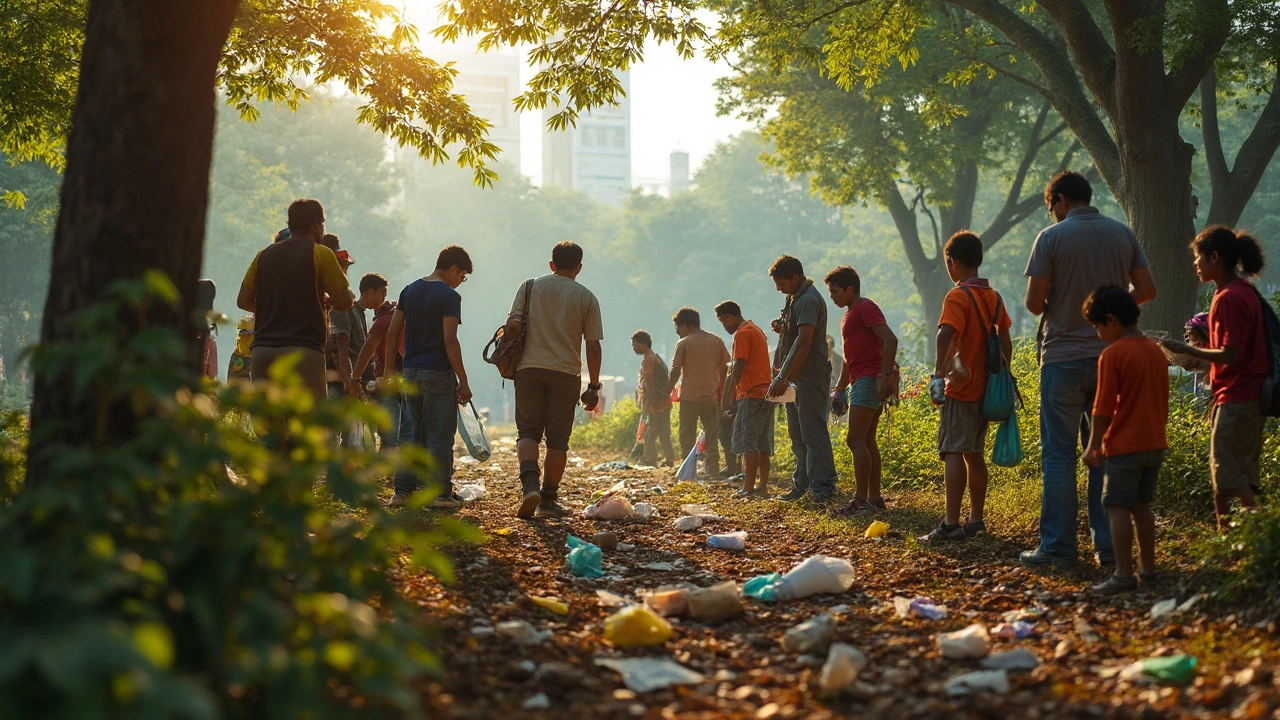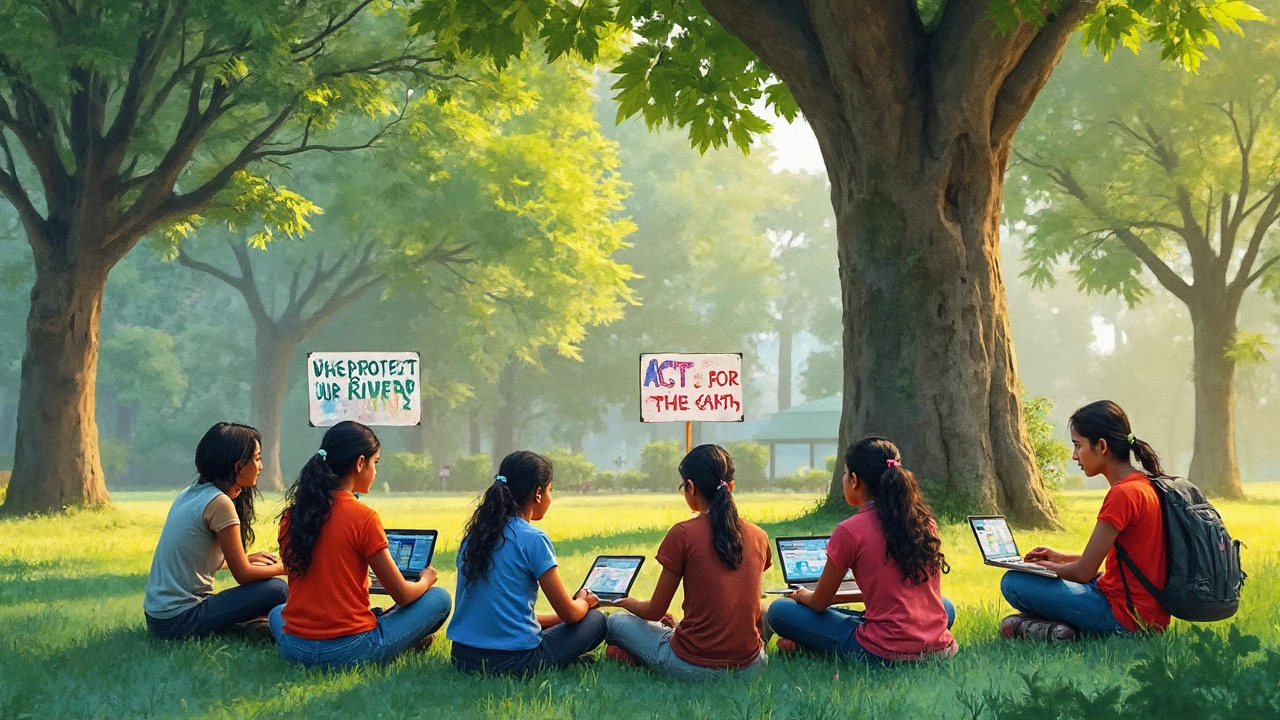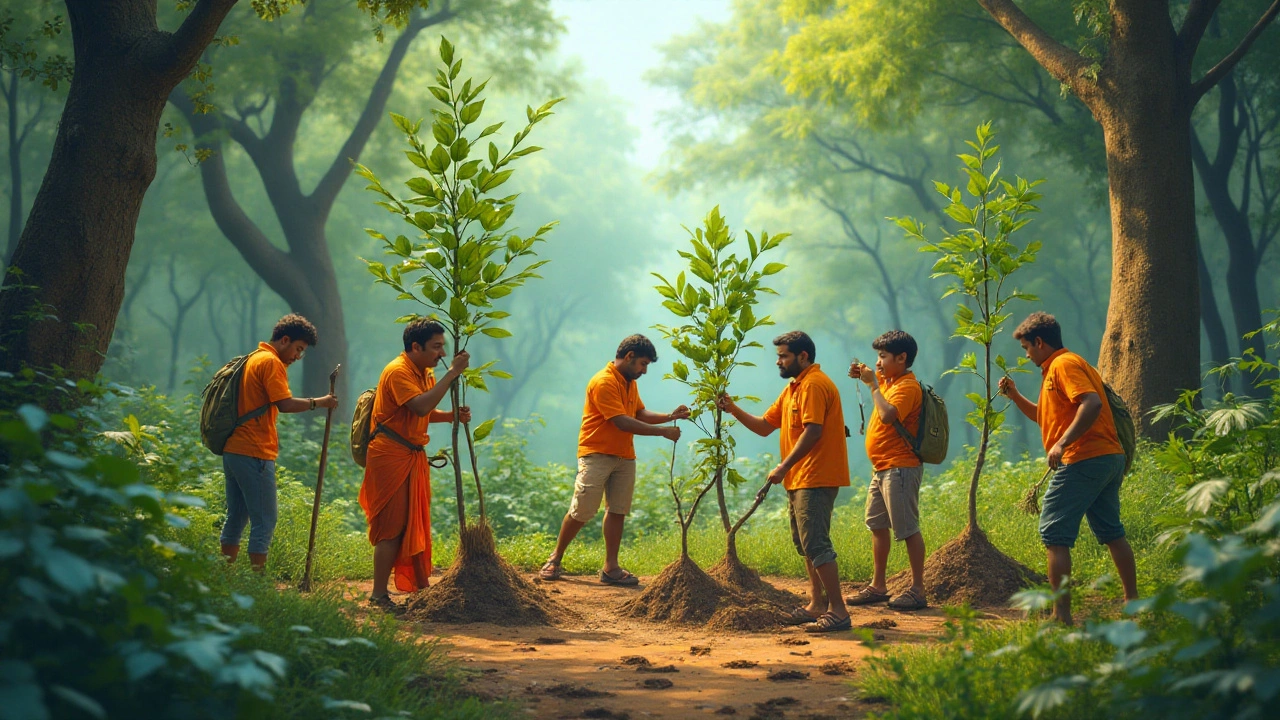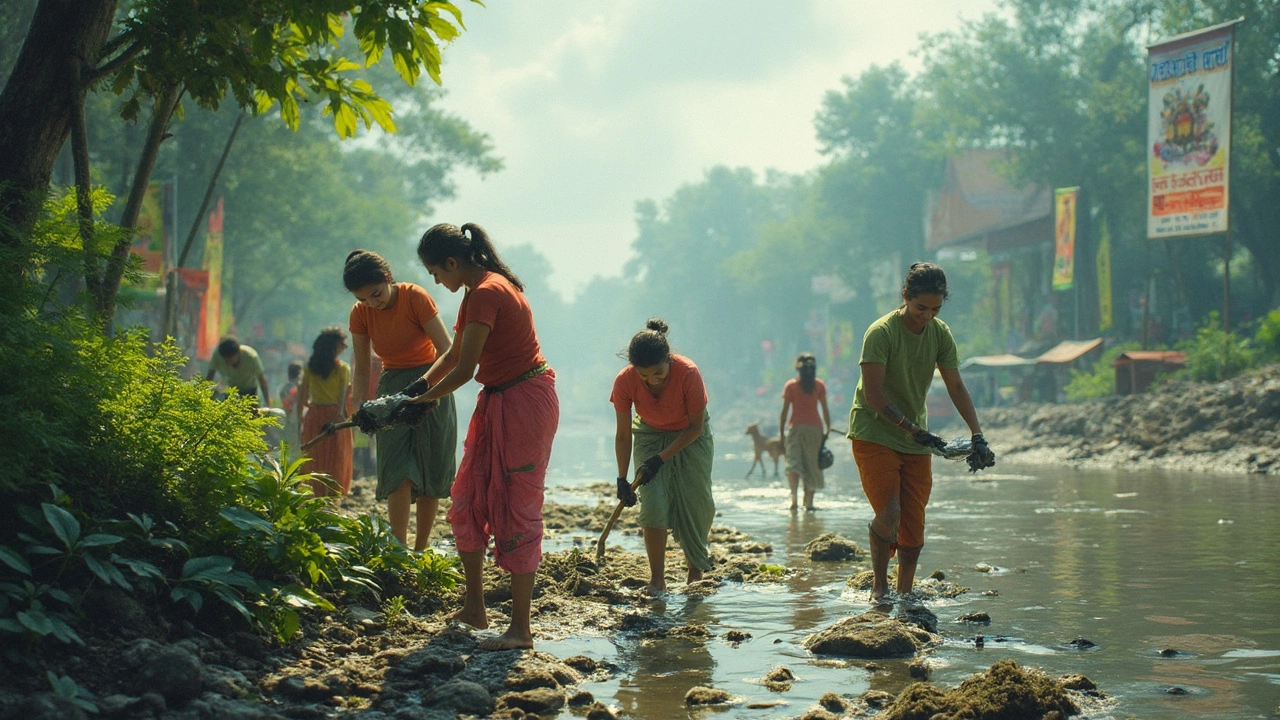Environmental groups play a crucial role in restoring and preserving our planet's natural resources. These groups are primarily categorized into three types: conservation organizations, sustainability advocates, and policy-focused groups. Each serves distinct purposes, from protecting wildlife habitats to influencing legislative changes. By understanding these categories, individuals can make informed decisions about where to lend their support. The article delves into the functions and impacts of each type, offering insights on how they collectively contribute to ecological well-being.

- Created by: Lydia Carmichael
- Completed on: 27 Apr 2025
- Categories: Environment
Ever think about who’s picking up the slack for our planet when the rest of us are busy with life? That’s where environmental groups come in. These aren’t just huge, faceless organizations; sometimes, they’re made up of your neighbors or friends, out there trying to turn the tide on pollution, climate change, or just keeping the local park clean.
There’s a lot of talk about “saving the environment,” but it can be tough to picture what that really looks like day to day. The cool part? Environmental groups handle a bit of everything. From planting trees to pushing for better laws, cleaning up local rivers, or even teaching kids how to recycle—there’s a whole range of ways these groups step up. If you’ve ever wondered about joining in or supporting them, you’ll find loads of easy tips and some surprising facts here.
- What Exactly Is an Environmental Group?
- How Do Environmental Groups Work?
- Famous Groups Making a Difference
- What Does 'Helping the Environment' Really Mean?
- Simple Ways to Support Green Organizations
- Cool Facts You Probably Didn’t Know
What Exactly Is an Environmental Group?
A environmental group is any organization that works to protect nature and improve our planet’s health. But this definition is just the tip of the iceberg. These groups can be big or small, local or global, and some have just a dozen volunteers, while others have millions of supporters. Think of names you might've heard before like Greenpeace or WWF (the World Wildlife Fund). On the flip side, there are smaller outfits like local river-cleanup teams or neighborhood tree planting clubs.
What do they actually do? It’s not just protesting or sending out emails (though sure, they do some of that). These organizations roll up their sleeves for all sorts of jobs:
- Organize clean-up events in parks, beaches, or rivers.
- Push for better laws on pollution, recycling, or protecting wildlife.
- Teach communities about climate change, energy use, or how to recycle.
- Fight companies in court when the environment is at risk.
- Research endangered plants, animals, and problems like global warming.
Some groups work with governments, while others stay totally independent. You’ll even spot some that focus on certain issues—like oceans, forests, or endangered animals—so anyone can find a cause they connect with.
Here’s a quick look at just how wide-reaching these environmental groups are:
| Type | Scale | Main Focus |
|---|---|---|
| Greenpeace | Global | Climate change, oceans, forests, pollution |
| Sierra Club | US (National & Local) | Public lands, clean energy, climate |
| Surfrider Foundation | Local (Beach communities) | Oceans, beaches, water quality |
| Local River Alliance | Local | River cleanup, water protection |
The bottom line: wherever you live, there’s probably a environmental group nearby trying to do some good. Some are loud and global, others quietly work right at home, but together they all help the planet—one project at a time.
How Do Environmental Groups Work?
Ever wonder what’s actually going on behind the scenes at environmental groups? Honestly, their work is all over the map—sometimes literally. A lot depends on the size of the group, but most of them have a few things in common. They spot a problem, rally some people, and put together a game plan. Simple, right?
Here’s how it usually plays out:
- Research and Advocacy: First off, they dig deep. Whether it’s climate change, wildlife protection, or cutting down plastic use, these groups gather real science-based facts. Big ones like Greenpeace or the Sierra Club spend a ton of time reading up, talking with experts, and backing up what they say.
- Community Projects: Think tree-planting drives, river cleanups, or building urban gardens. Local environmental groups are usually hands-on, recruiting everyday people to help out. Last year, one group in the UK planted a million trees by getting schools and businesses involved. It works because everyone can pitch in.
- Legal Action: Sometimes things get official. When companies or governments are hurting the environment, these groups take them to court. The National Resources Defense Council (NRDC) is known for powerful lawsuits that pushed new clean air rules in the US.
- Education and Awareness: You’ll find these groups in schools, on social media, and even out at farmers’ markets, showing people how to cut waste or save energy. They know fixing things for good means getting the word out.
- Lobbying: This means convincing politicians to support stronger environmental laws. The World Wildlife Fund (WWF) has helped pass several bills that protect endangered species by simply rallying enough votes.
Here’s a quick look at what different types of groups focus on:
| Type of Group | Main Focus | Example |
|---|---|---|
| Local | Cleanups & education | Friends of the LA River |
| National | Policy change & big campaigns | The Sierra Club |
| International | Global conservation | Greenpeace, WWF |
If you want to get involved, groups are always looking for volunteers, donors, or just folks willing to spread the word. You don’t have to be an expert to help out—sometimes, they just need people-power for a weekend cleanup or a voice on a petition.
Famous Groups Making a Difference
If you’re looking for examples of environmental groups that are really doing the work, a few names pop up over and over. These groups aren’t just popular because they’ve been around for a while—they’re known for making real changes on the ground.
Greenpeace is probably one of the most recognized. Started in 1971, they go big by exposing environmental problems around the world—think forests, oceans, and the fight against single-use plastics. Greenpeace activists are famous for bold actions, like climbing oil rigs to protest drilling in the Arctic. They’re not just loud; their campaigns have helped push companies to stop deep-sea dumping and even helped pass international bans on whale hunting.
World Wildlife Fund (WWF) comes with that cute panda logo, but they’re fierce when it comes to protecting wildlife. WWF has more than five million supporters worldwide. Their campaigns have helped save countless species from extinction and they work everywhere, from local jungles to the global stage, dealing with issues like deforestation and overfishing. Fun fact: Their efforts helped double Nepal’s wild tiger population in the last decade.
Ever heard of The Sierra Club? It’s an American classic—founded way back in 1892. They started with preserving natural wonders in the U.S., but now work on climate change and making clean energy more accessible. Sierra Club’s lobbying efforts helped create many of the national parks we take for granted today.
Here’s a quick look at some of what these green organizations have achieved:
| Group | Founded | Key Achievement |
|---|---|---|
| Greenpeace | 1971 | International ban on commercial whaling |
| WWF | 1961 | Doubling tiger population in Nepal (2010-2022) |
| Sierra Club | 1892 | Helped create U.S. National Parks |
These groups helping the environment each have their own style—some are boots-on-the-ground, some focus on big policy changes. But they’re all about making sure the planet’s future looks a bit brighter. If the idea of diving in feels intimidating, it’s good to remember that every big movement got its start somewhere. And all these organizations are always on the lookout for new people to join in, whether you’ve got an hour or a lifetime to give.

What Does 'Helping the Environment' Really Mean?
Sometimes, people toss around the phrase “helping the environment” like it’s just about picking up some litter. It’s way more than that. At the heart of it, environmental groups step in to tackle big issues that affect everyone. This can mean fighting climate change, saving endangered animals, keeping water and air clean, and cutting down on waste. Each group has its own focus, but the end goal is always making the planet healthier.
You might hear about recycling, tree planting, or switching to renewable energy—these are among the main things these environmental groups push for. Why? Because every one of those actions chips away at problems like global warming and pollution. For example, recycling one ton of paper can save around 17 trees and over 7,000 gallons of water. That might not sound like much, but it adds up fast.
Let’s get specific. Here’s what “helping the environment” looks like in action:
- Restoring forests and planting trees – Trees absorb carbon dioxide, which is the main gas heating up our planet.
- Cleaning up rivers, beaches, and parks – Trash in waterways can kill fish and turtles and even end up in our food chain.
- Protecting wildlife habitats – Groups build safe zones so animals don’t lose their homes to development or pollution.
- Pushing for eco-friendly laws – They campaign for things like stricter limits on smog or banning plastic bags in stores.
- Educating the public – Teaching people simple habits, like reusing stuff or saving energy, makes a bigger difference than you’d think.
You might be surprised to know that in 2023, about 79% of plastic waste in the U.S. wasn’t recycled, but just tossed out. Groups focused on recycling keep that number in the spotlight and drive change by encouraging cities to invest in better recycling programs.
So, when you hear about green organizations stepping up, remember it’s not just about hugging trees. They’re making a dent—sometimes in small, unglamorous ways. Yet, each victory, no matter how tiny, adds up to a cleaner, safer planet for everyone.
Simple Ways to Support Green Organizations
You don’t need to change your whole life to help environmental groups. Sometimes, it’s the small steps that add up fast and actually make a dent. Wondering what you can do that really counts? Here’s what works for regular people:
- Donate—any amount helps. Most green organizations run on donations. Even $5 can help buy seeds for a tree-planting event or supplies for a river cleanup. And, in the U.S., donations to registered environmental non-profits are usually tax-deductible.
- Volunteer your time. If you like getting your hands dirty (literally), sign up for a local park cleanup or a tree-planting day. Some groups always need help with office work, social media, or organizing events too.
- Share and follow online. Spreading the word is underrated. Most people find out about green organizations through friends or social media. Hit share, re-tweet, or just tell your friends about a cool project you saw.
- Join a local chapter. Groups like the Sierra Club and Greenpeace have city-based chapters where you can meet others who care, join activities, and get updates about local issues.
- Shop smart. Some environmental groups fund themselves by selling merch like reusable water bottles, tote bags, or t-shirts. Buying these is a double win—you get gear you’d probably use anyway, and the profits go to a good cause.
If you’re more into big impact, you can get involved in advocacy. Look for petitions to sign, send an email to your local rep, or show up at public meetings. Groups like Friends of the Earth often have ready-made scripts and tools on their websites to make it easier.
Want to see how little things add up? Check this out:
| Action | Possible Impact (per year) |
|---|---|
| Monthly $10 donation | Buys 24 native trees for restoration |
| Volunteering twice a year | Removes 100+ lbs. of trash from local parks |
| Recruiting three friends | Triples donation power or work hours for cleanup events |
You don’t need a science degree, a camera crew, or piles of money to back a group helping the planet. Try one or two of these—your impact is more real than it seems.
Cool Facts You Probably Didn’t Know
Let’s get real—environmental groups are more than just folks waving signs or planting trees. They pull off some pretty amazing stunts, and there’s a lot most people don’t realize about how wide their impact goes.
- One recycled aluminum can saves enough energy to charge a smartphone 30 times. Some green organizations have entire programs focused just on recycling efforts like this—and they actually track results.
- Greenpeace, one of the biggest environmental groups around, operates two full-on research ships that travel the world to gather evidence about ocean pollution and illegal fishing.
- The Sierra Club helped create the National Park Service in the U.S. back in 1916. That one move set aside millions of acres for nature, so regular people could hike, camp, or just chill out in places that might otherwise have been lost to development.
- 350.org, a group fighting climate change, got their name from the safe level of carbon dioxide in the atmosphere: 350 parts per million. We’re currently way over that, which is a problem they’re racing to fix.
Some groups run community gardens, which sounds simple but massively cuts food miles (the distance food travels to get to your plate) and helps lower carbon pollution one tomato at a time.
| Group | Focus Area | Notable Impact |
|---|---|---|
| Greenpeace | Oceans & Forests | Stopped several illegal whaling operations |
| World Wildlife Fund (WWF) | Wildlife Conservation | Helped double wild tiger populations in key areas |
| Friends of the Earth | Sustainable Living | Helped pass pesticide bans that protected bees |
Want another fun one? There’s a thing called the Great Global Cleanup. Every year, people in over 180 countries join up thanks to environmental groups—all for one simple reason: trash doesn’t pick itself up. Last year, they removed over 130 million pounds of waste!
Underneath the big campaigns and viral videos, there are thousands of regular people powering these wins. Doesn’t matter if it’s fighting plastic pollution or bringing back endangered animals—if you care about the planet, odds are there’s an environmental group out there already doing the heavy lifting, and probably looking for another set of hands.
Wondering which environmental groups actually do something? This article breaks down how to spot real action-takers versus loud talkers, and shares tips for getting involved whether you like to join big organizations or prefer hands-on community groups. Learn where your efforts and donations go furthest, and get inspired by success stories you might not know. If the planet’s future matters to you, you’ll find concrete steps here.
If you’ve ever wondered who is out there fighting for the environment, this article breaks down what environmental groups are, how they work, and why they matter. You’ll get the inside scoop on what these groups actually do, see some examples in action, and pick up ideas to get involved yourself. There's a lot more to these organizations than tree planting. By the end, you’ll know exactly how environmental groups can make a real difference—and how you can support them.

